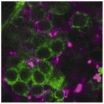(Press-News.org) PHILADELPHIA — A new study in a mutant fruitfly called sleepless (sss) confirmed that the enzyme GABA transaminase, which is the target of some epilepsy drugs, contributes to sleep loss. The findings, published online in Molecular Psychiatry, were led by Amita Sehgal, PhD, head of the Chronobiology Program at the University of Pennsylvania's Perelman School of Medicine. The findings shed light on mechanisms that may be shared between sleep disruption and some neurological disorders. A better understanding of this connection could enable treatments that target both types of symptoms and perhaps provide better therapeutic efficacy.
"Epilepsy is essentially an increase-in-firing disorder of the brain and maybe a decrease in activity of the neurotransmitter GABA, too," says Sehgal, who is also a professor of Neuroscience and an investigator with the Howard Hughes Medical Institute (HHMI). "This connects our work to drugs that inhibit GABA transaminase. Changes in GABA transaminase activity are implicated in epilepsy and some other psychiatric disorders, which may account for some of the associated sleep problems."
The team looked at the proteomics of the sss mutant brain – a large-scale study of the structure and function of related proteins -- and found that GABA transaminase is increased in the sss brain compared to controls. This enzyme breaks down GABA, so GABA is decreased in the sss brain. Because GABA promotes sleep, there is a decrease in sleep in the sss mutant fly, as the name implies.
The relationship between the SSS protein and GABA is not fully understood. The SSS protein controls neural activity, and its absence results in increased neural firing, which likely uses up a lot of energy, says Sehgal. GABA transaminase works in the mitochondria, the energy-production organelle in the glial cells of the brain, which provide fuel for neurons. The large energy demand created by the increased neural firing in sss brains probably alters mitochondrial metabolism, including GABA transaminase function in glia.
In the sss mutant fly, there is a stream of connections that leads to its signature loss of sleep: The sss mutant has increased neuron firing caused by downregulation of a potassium channel protein called Shaker. Recently, the Sehgal lab showed that SSS also affects activity of acetylcholine receptors. Both of these actions may directly cause an inability to sleep. In addition, increased energy demands on glia, which increase GABA transaminase and decrease GABA, may further contribute to sleep loss. On the other hand, if GABA is increased, then sleep is increased, as in flies that lack GABA transaminase.
INFORMATION:
Coauthors are Wen-Feng Chen, Sarah Maguire, Mallory Sowcik, Wenyu Luo, all from Penn and Kyunghee Koh from Thomas Jefferson University. The study was funded by HHMI.
Penn Medicine is one of the world's leading academic medical centers, dedicated to the related missions of medical education, biomedical research, and excellence in patient care. Penn Medicine consists of the Raymond and Ruth Perelman School of Medicine at the University of Pennsylvania (founded in 1765 as the nation's first medical school) and the University of Pennsylvania Health System, which together form a $4.3 billion enterprise.
The Perelman School of Medicine has been ranked among the top five medical schools in the United States for the past 17 years, according to U.S. News & World Report's survey of research-oriented medical schools. The School is consistently among the nation's top recipients of funding from the National Institutes of Health, with $392 million awarded in the 2013 fiscal year.
The University of Pennsylvania Health System's patient care facilities include: The Hospital of the University of Pennsylvania -- recognized as one of the nation's top "Honor Roll" hospitals by U.S. News & World Report; Penn Presbyterian Medical Center; Chester County Hospital; Penn Wissahickon Hospice; and Pennsylvania Hospital -- the nation's first hospital, founded in 1751. Additional affiliated inpatient care facilities and services throughout the Philadelphia region include Chestnut Hill Hospital and Good Shepherd Penn Partners, a partnership between Good Shepherd Rehabilitation Network and Penn Medicine.
Penn Medicine is committed to improving lives and health through a variety of community-based programs and activities. In fiscal year 2013, Penn Medicine provided $814 million to benefit our community.
Fruitfly study: Epilepsy drug target implications for sleep disruption in brain disorders
2014-04-01
ELSE PRESS RELEASES FROM THIS DATE:
ED dental care treatment raises access, cost issues for policymakers, Rutgers study finds
2014-04-01
NEW BRUNSWICK, N.J. – The use of emergency departments for dental care – especially by young adults in low-income communities – is presenting policymakers with a challenge, according to a Rutgers report which offers several remedies including expanding hours at the dentist's office.
"Emergency departments are poorly equipped to deal definitively with dental and oral health needs," said Kristen Lloyd, senior analyst at Rutgers' Center for State Health Policy and lead author of the report. "Still, many people seek care in emergency departments for nontraumatic dental ...
Schools have limited success in reducing bullying, new analysis finds
2014-04-01
Two UCLA professors who conducted the most thorough analysis to date of studies on school bullying have found that K-12 schools' efforts to curtail bullying are often disappointing.
The study revealed that schools are trying many different approaches to protect students, and while the more comprehensive programs have been the most effective, they require substantial commitment and school resources to be successful.
"Band-Aid solutions, such as holding one assembly a year that discourages bullying, do not work," said Jaana Juvonen, a UCLA professor of psychology ...
Oxytocin, the 'love' hormone, promotes group lying, according to Ben-Gurion U. researchers
2014-04-01
BEER-SHEVA, Israel…April 1, 2014 – According to a new study by researchers at Ben-Gurion University of the Negev (BGU) and the University of Amsterdam, oxytocin caused participants to lie more to benefit their groups, and to do so more quickly and without expectation of reciprocal dishonesty from their group. Oxytocin is a hormone the body naturally produces to stimulate bonding.
The research was published this week in the Proceedings of the National Academy of Science (PNAS).
"Our results suggest people are willing to bend ethical rules to help the people close to ...
Factor present in gestational and type 2 diabetes could provide new treatment options
2014-04-01
New research reveals that both pregnant women with diabetes and with type 2 diabetics have high levels of a fat metabolite that impairs pancreatic cells from secreting insulin. The findings, which are published in the April 1 issue of the Cell Press journal Cell Metabolism, suggest that blocking the effects of this fat metabolite may help prevent and treat diabetes.
In nearly one-fifth of pregnancies, diabetes can arise (called gestational diabetes), and when this happens, it puts the woman at an increased risk for developing type 2 diabetes later in life. To gain better ...
Obesity primes the colon for cancer, according to NIH study
2014-04-01
Obesity, rather than diet, causes changes in the colon that may lead to colorectal cancer, according to a study in mice by the National Institutes of Health. The finding bolsters the recommendation that calorie control and frequent exercise are not only key to a healthy lifestyle, but a strategy to lower the risk for colon cancer, the second leading cause of cancer-related death in the United States.
Paul Wade, Ph.D., and Thomas Eling, Ph.D., scientists at the National Institute of Environmental Health Sciences (NIEHS), part of NIH, led a collaborative team that made ...
Common molecular defect offers treatment hope for group of rare disorders
2014-04-01
DURHAM, N.C. – Duke Medicine researchers studying tiny, antennae-like structures called cilia have found a potential way to ease some of the physical damage of numerous genetic disorders that result when these essential cellular components are defective.
Different genetic defects cause dysfunction of the cilia, which often act as sensory organs that receive signals from other cells. Individually, disorders involving cilia are rare, but collectively the more than 100 diseases in the category known as ciliopathies affect as many as one in 1,000 people. Ciliopathies are ...
Swimming pool urine combines with chlorine to pose health risks
2014-04-01
WEST LAFAYETTE, Ind. - A new study shows how uric acid in urine generates potentially hazardous "volatile disinfection byproducts" in swimming pools by interacting with chlorine, and researchers are advising swimmers to observe "improved hygiene habits."
Chlorination is used primarily to prevent pathogenic microorganisms from growing. The disinfection byproducts include cyanogen chloride (CNCl) and trichloramine (NCl3). Cyanogen chloride is a toxic compound that affects many organs, including the lungs, heart and central nervous system by inhalation. Trichloramine has ...
Got acne? There's an App for that!
2014-04-01
CHICAGO --- Acne sufferers around the world are using an iPhone app created at Northwestern University to learn how certain foods affect their skin conditions.
The app, called "diet & acne," can be downloaded from the iTunes app store for free. It uses data from a systematic analysis of peer-reviewed research studies to show people if there is or is not scientific evidence linking acne to foods such as chocolate, fat, sugar and whey protein.
"Users may be surprised to learn that there is no conclusive evidence from large randomized controlled trials that have linked ...
Plugged in but powered down
2014-04-01
It's not news that being a couch potato is bad for your health. Lack of physical activity is associated with a range of diseases from diabetes to heart attacks. It now turns out that young men who have experienced depression early in life may be especially vulnerable to becoming sedentary later in life. And particularly to spending large amounts of time online each day.
A study of 761 adults in Montreal who were identified at the age of 20 as suffering from the symptoms of depression (in 2007-08) were asked by researchers to keep track of how much leisure time they spent ...
Good vibrations: Using light-heated water to deliver drugs
2014-04-01
Researchers from the University of California, San Diego Skaggs School of Pharmacy and Pharmaceutical Sciences, in collaboration with materials scientists, engineers and neurobiologists, have discovered a new mechanism for using light to activate drug-delivering nanoparticles and other targeted therapeutic substances inside the body.
This discovery represents a major innovation, said Adah Almutairi, PhD, associate professor and director of the joint UC San Diego-KACST Center of Excellence in Nanomedicine. Up to now, she said, only a handful of strategies using light-triggered ...


